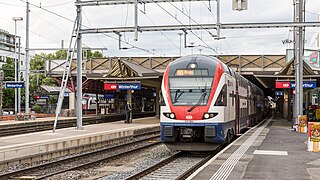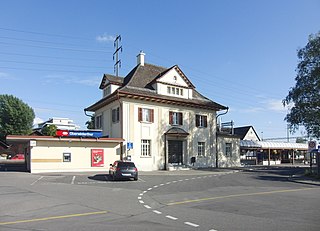
Switzerland has a dense network of roads and railways. The Swiss public transport network has a total length of 24,500 kilometres and has more than 2600 stations and stops.

The Rhine Falls is a waterfall located in Switzerland and the most powerful waterfall in Europe. The falls are located on the High Rhine on the border between the cantons of Schaffhausen (SH) and Zürich (ZH), between the municipalities of Neuhausen am Rheinfall (SH) and Laufen-Uhwiesen/Dachsen (ZH), next to the town of Schaffhausen in northern Switzerland.

The canton of Schaffhausen, also canton of Schaffhouse, is the northernmost canton of Switzerland. The principal city and capital of the canton is Schaffhausen. The canton's territory is divided into three non-contiguous segments, where German territory reaches the Rhine. The large central part, which includes the capital, in turn separates the German exclave of Büsingen am Hochrhein from the rest of Germany.

The A13 is a motorway, at times an Autostrasse (expressway), which runs from St. Margrethen in northeastern Switzerland through to Ascona in southern Switzerland, crossing the main chain of the Alps in the Grisons area. It is the southern half of European route E43.

The Zurich S-Bahn system is a network of rail lines that has been incrementally expanded to cover the ZVV area, which comprises the entire canton of Zurich and portions of neighbouring cantons, with a few lines extending into or crossing the territory of southern Germany. The network is one of many commuter rail operations in German speaking countries to be described as an S-Bahn. The lines connect with services of Aargau S-Bahn to the West, Basel S-Bahn and Schaffhausen S-Bahn to the North, St. Gallen S-Bahn to the East, and Lucerne S-Bahn/Zug Stadtbahn to the South, as well as with InterCity, InterRegio and RegioExpress services at major junction stations.

The Cholfirst Tunnel is a tunnel in Switzerland. The tunnel lies in the northern canton of Zuerich, and forms part of the Autostrasse A4. It was completed in 1996, and is 1,260 metres (4,130 ft) long.

Neuhausen am Rheinfall is a town and a municipality in the canton of Schaffhausen in Switzerland. The town is close to the Rhine Falls, mainland Europe's largest waterfall.
Switzerland has a two-class highway system: motorways with separated roads for oncoming traffic and a standard maximal speed limit of 120 kilometres per hour (75 mph), and expressways often with oncoming traffic and a standard maximal speed limit of 100 kilometres per hour (62 mph).

Thurbo is a railway company with mostly S-Bahn-style services in Switzerland, southern Germany, and northwestern Vorarlberg, Austria, jointly owned by Swiss Federal Railways (90%) and the canton of Thurgau.

The A16, a motorway in north-central Switzerland, is a divided freeway connecting the border to France to the A5 motorway, 84 kilometres (52 mi) to the south on the Swiss plateau.

The High Rhine Railway is a Deutsche Bahn railway line from Basel Badischer Bahnhof in the city of Basel to Konstanz on Lake Constance. It was built by the Grand Duchy of Baden State Railways as part of the Baden Mainline, which follows the Rhine upstream from Mannheim Hauptbahnhof to Konstanz. The line derives its name from the High Rhine, which it follows between Basel and Waldshut and on a short section in Schaffhausen.

The S12 is a regional railway line of the S-Bahn Zürich on the Zürcher Verkehrsverbund (ZVV), Zürich transportation network. The S12 is one of the network's lines connecting the cantons of Zürich, Aargau, Schaffhausen, Thurgau and St. Gallen.

Winterthur railway station is the principal railway station of Winterthur, in the Swiss canton of Zürich. The station is listed on the Swiss Inventory of Cultural Property of National Significance.

Oberwinterthur railway station is a railway station that serves Oberwinterthur, which is district number 2 in Winterthur, a city in the Canton of Zurich, Switzerland.

The S24 is a regional railway line of the Zürich S-Bahn of the Zürcher Verkehrsverbund (ZVV), Zürich transportation network. The line was significantly extended in June 2014, and again in December 2015, and has subsumed the former S21 line previously providing service in parts of its extended route.

Schaffhausen railway station is a railway station in Schaffhausen, the capital of the Swiss canton of Schaffhausen. The station is jointly owned by the Swiss Federal Railways (SBB CFF FFS) and Deutsche Bahn (DB), and is served by trains of both national operators, as well as trains of the Swiss regional operator Thurbo.

The Rheinfall Railway is a railway line in Switzerland. The line links Winterthur in the canton of Zurich with Schaffhausen in the canton of Schaffhausen. The Rheinfall Railway was constructed by the independent Rheinfallbahn-Gesellschaft.

The Eglisau–Neuhausen railway line is a cross-border railway line in Germany and Switzerland. It links Eglisau in the Swiss canton of Zurich with the city of Schaffhausen in the Swiss canton of Schaffhausen, crossing some 8 kilometres (5.0 mi) of the German state of Baden-Württemberg in between. It thus crosses the Germany–Switzerland border twice. The line is 17.88 kilometres (11.11 mi) long, standard gauge and electrified at 15 kV 16.7 Hz AC supplied by overhead line. It is formed of a mixture of single and double track sections.

The Zurich–Winterthur railway is Switzerland's busiest railway line. Opened in 1855, it runs from Zürich Hauptbahnhof to Winterthur via several routes. It is a bottleneck in Swiss rail transport. Practically all lines of the core network of the Zurich S-Bahn use parts of this line.

The Hauptstrasse 13 is a main road (“Hauptstrasse”) in the Swiss cantons of Schaffhausen, Zürich, Thurgau, St. Gallen, Grisons and Ticino. This main road begins at the German border at Trasadingen at the Bundesstraße 34 and ends at the Strada Statale 34 at the Italian border at Brissago. Between the border crossing Trasadingen / Erzingen and the A4 at Schaffhausen it is part of European route E54. The total length of Hauptstrasse 13 is approximately 320 kilometers.























